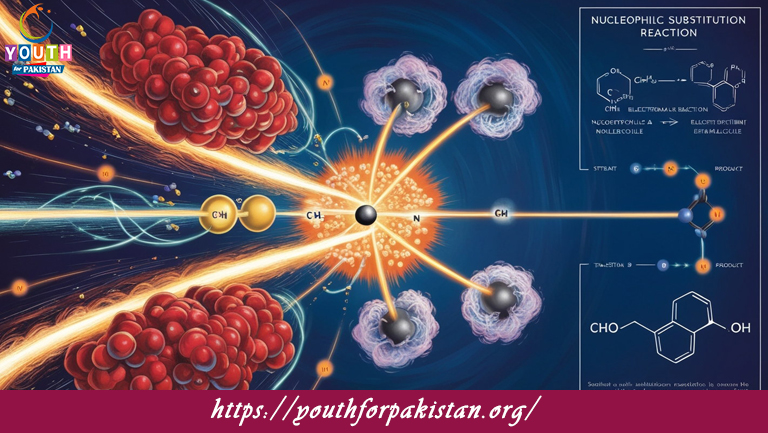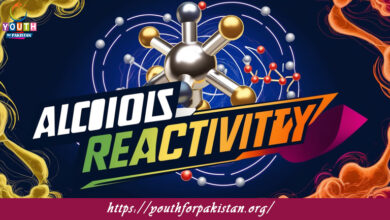Nucleophilic Substitution Reaction MDCAT MCQs with Answers

Welcome to the Nucleophilic Substitution Reaction MDCAT MCQs with Answers. In this post, we have shared Nucleophilic Substitution Reaction Multiple Choice Questions and Answers for PMC MDCAT 2024. Each question in MDCAT Chemistry offers a chance to enhance your knowledge regarding Nucleophilic Substitution Reaction MCQs in this MDCAT Online Test.
What is the general mechanism for an SN2 reaction?
a) Two-step mechanism
b) Concerted mechanism
c) Carbocation intermediate
d) Radical intermediate
In an SN1 reaction, the rate-determining step involves:
a) Nucleophile attack
b) Carbocation formation
c) Leaving group departure
d) Base removal
Which factor does NOT affect the rate of an SN2 reaction?
a) Nucleophile strength
b) Substrate steric hindrance
c) Solvent polarity
d) Leaving group ability
What type of solvent is generally preferred for an SN2 reaction?
a) Polar protic
b) Non-polar
c) Polar aprotic
d) Hydrocarbon
Which of the following substrates is most likely to undergo an SN1 reaction?
a) Primary alkyl halide
b) Secondary alkyl halide
c) Tertiary alkyl halide
d) Methyl halide
In an SN2 reaction, the nucleophile attacks from which direction relative to the leaving group?
a) Same side
b) Opposite side
c) Above
d) Below
Which of the following is a characteristic of an SN1 mechanism?
a) Inversion of configuration
b) Stereochemistry retention
c) Formation of a racemic mixture
d) Concerted step
What is the key intermediate in an SN2 reaction?
a) Carbocation
b) Transition state
c) Radicals
d) Anion
Which reaction mechanism is favored by a strong nucleophile?
a) SN1
b) SN2
c) E1
d) E2
For which reaction mechanism is the rate dependent on both the substrate and the nucleophile?
a) SN1
b) SN2
c) E1
d) E2
Which factor generally decreases the rate of an SN2 reaction?
a) Strong nucleophile
b) Non-polar solvent
c) Primary substrate
d) Steric hindrance
In which type of reaction does the nucleophile attack the substrate while the leaving group departs?
a) SN2
b) SN1
c) E1
d) E2
What is a common feature of SN1 reactions?
a) Single step
b) Transition state formation
c) Racemization of chiral centers
d) Strong base requirement
Which type of substrate is least likely to undergo an SN1 reaction?
a) Tertiary
b) Secondary
c) Primary
d) Methyl
In which reaction does the nucleophile and the leaving group both participate in the rate-determining step?
a) SN2
b) E2
c) SN1
d) E1
What type of nucleophile is typically used in an SN1 reaction?
a) Strong
b) Weak
c) Neutral
d) Basic
Which of the following is a feature of an SN2 reaction?
a) Formation of a racemic mixture
b) Inversion of configuration
c) Formation of a carbocation
d) Use of a polar protic solvent
Which solvent type is generally not suitable for SN2 reactions?
a) Polar aprotic
b) Non-polar
c) Polar protic
d) Aprotic
The rate of an SN1 reaction is directly proportional to:
a) Nucleophile concentration
b) Substrate concentration
c) Base concentration
d) Solvent polarity
Which of the following reactions involves a transition state where the nucleophile and leaving group are both partially bonded to the substrate?
a) SN1
b) E1
c) SN2
d) E2
In which type of reaction mechanism does the leaving group leave before the nucleophile attacks?
a) SN2
b) E2
c) E1
d) SN1
Which factor promotes an SN2 reaction over an SN1 reaction?
a) Strong nucleophile
b) Tertiary substrate
c) Polar protic solvent
d) Weak base
What is the typical product of an SN2 reaction with a chiral substrate?
a) Racemic mixture
b) Inverted configuration
c) Retained configuration
d) No stereochemical change
Which reaction mechanism usually involves a carbocation intermediate?
a) SN2
b) E2
c) SN1
d) E1
For which reaction mechanism is the nucleophile not required to be strong?
a) SN2
b) E2
c) E1
d) Both E1 and SN2
Which substrate type is generally most reactive in an SN1 reaction?
a) Primary
b) Secondary
c) Tertiary
d) Methyl
Which reaction mechanism involves a leaving group and nucleophile in a single transition state?
a) SN1
b) E1
c) SN2
d) E2
In which reaction mechanism does the nucleophile attack the substrate in a single step?
a) E2
b) SN1
c) SN2
d) E1
Which condition generally disfavors SN1 reactions?
a) Weak nucleophile
b) Polar protic solvent
c) Tertiary alkyl halide
d) Strong nucleophile
Which reaction type involves a rate law that includes the concentration of the substrate and nucleophile?
a) SN1
b) E1
c) SN2
d) E2
In an SN1 reaction, what usually occurs to the stereochemistry of the substrate?
a) Retention of configuration
b) Inversion of configuration
c) Racemization
d) No change
The use of a strong base generally favors which reaction mechanism?
a) SN1
b) E1
c) SN2
d) E2
Which of the following is least likely to be a nucleophile in SN2 reactions?
a) Hydroxide ion
b) Chloride ion
c) Cyanide ion
d) Methanol
What type of intermediate is formed in an SN1 reaction?
a) Carbanion
b) Carbocation
c) Transition state
d) Radical
Which factor generally increases the rate of an SN2 reaction?
a) Increased steric hindrance
b) Polar protic solvent
c) Strong nucleophile
d) Tertiary substrate
In an SN2 reaction, which factor is most critical for a successful reaction?
a) High concentration of nucleophile
b) High temperature
c) Strong base
d) Non-polar solvent
Which type of reaction mechanism involves the formation of a carbocation intermediate and a racemic mixture?
a) SN1
b) SN2
c) E2
d) E1
Which substrate is least likely to undergo an SN2 reaction?
a) Methyl halide
b) Primary alkyl halide
c) Secondary alkyl halide
d) Tertiary alkyl halide
What is a common feature of an E2 reaction?
a) Formation of a carbocation
b) Use of a strong base
c) Single-step mechanism
d) Formation of a racemic mixture
In an SN2 reaction, what is the typical effect of a bulky nucleophile?
a) Increased reaction rate
b) Decreased reaction rate
c) No effect
d) Formation of a carbocation
If you are interested to enhance your knowledge regarding Physics, Chemistry, Computer, and Biology please click on the link of each category, you will be redirected to dedicated website for each category.




